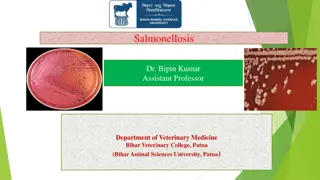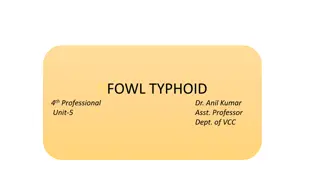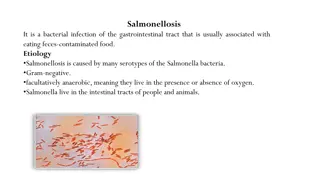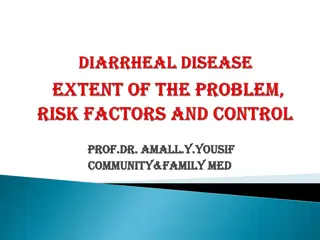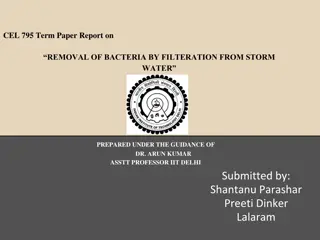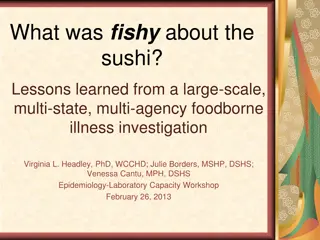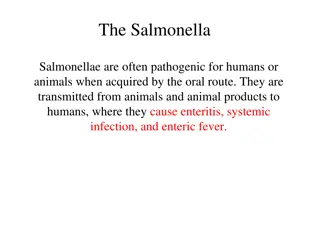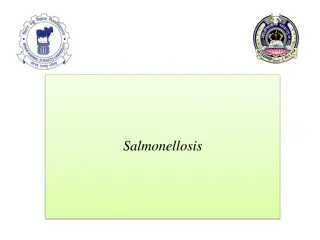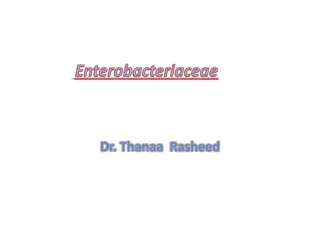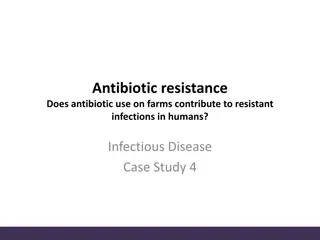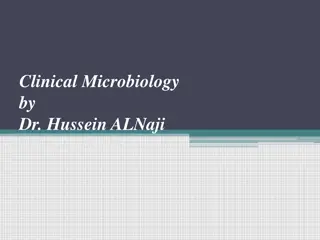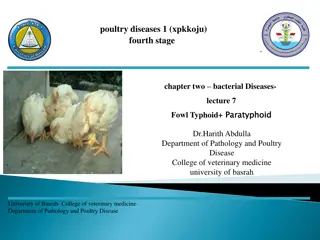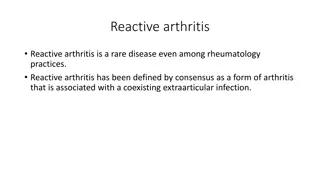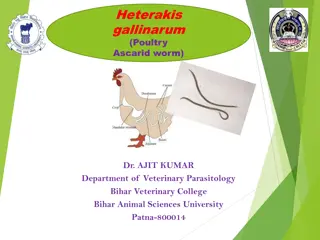Salmonellosis: Causes, Clinical Presentations, and Transmission
Salmonellosis is caused by the gram-negative bacterium Salmonella enterica. It predominantly affects warm-blooded vertebrates, leading to carrier states, septicemia, enteritis, and other clinical presentations like abortion and arthritis. The disease is transmitted through contaminated foods of anim
0 views • 15 slides
Understanding Enteric Fever (Typhoid Fever): Causes, Contagiousness, and Prognosis
Enteric fever, commonly known as typhoid fever, is an acute illness caused by Salmonella typhi bacteria transmitted through contaminated food or water. This fever is highly contagious, with individuals becoming carriers even after recovering. Close contact, contaminated water, and poor sanitation co
0 views • 18 slides
Understanding Food and Water-Borne Diseases: Causes and Classification
Food and water-borne diseases, caused by contaminated food or water, lead to acute illnesses. These diseases are classified into food-borne infections and food-borne intoxications. Food-borne infections, triggered by pathogenic microorganisms, can be fungal, bacterial, viral, or parasitic, with long
3 views • 57 slides
Understanding Salmonella and Shigella Pathogenesis, Clinical Features, and Management
Explore the algorithms for identifying Salmonella and Shigella, their antigenic structures, virulence factors, pathogenesis, clinical features, and management concepts. Understand the characteristics, transmission, and prevention strategies for these gastrointestinal pathogens.
0 views • 30 slides
Understanding Fowl Typhoid: Causes, Transmission, Clinical Signs, and Control Measures
Fowl typhoid, caused by Salmonella gallinarum, affects adult chickens with high mortality rates. It spreads through infected droppings, carcasses, and fomites. Clinical signs include listlessness, diarrhea, and organ swelling. Diagnosis involves isolation and identification, while treatment options
0 views • 4 slides
Understanding Salmonellosis: Causes, Symptoms, and Prevention
Salmonellosis is a bacterial infection of the gastrointestinal tract caused by various serotypes of Salmonella bacteria. It affects both animals and humans, commonly spread through contaminated food sources. Symptoms in humans include diarrhea, abdominal cramps, and fever, with potential complicatio
0 views • 8 slides
Understanding Salmonella: A Zoonotic Pathogen
Salmonella, a genus of bacteria, includes species causing various diseases in humans, cattle, sheep, goats, and poultry. The pathogen can be transmitted through contaminated food and is classified into typhoidal and nontyphoidal serovars. Nontyphoidal serovars are common and typically lead to self-l
0 views • 20 slides
Understanding Feco-Oral Diseases and Diarrhea Transmission
Feco-oral diseases, primarily transmitted through the fecal-oral route, remain a significant global health concern, especially affecting children under 5 and the elderly. Diarrhea, characterized by WHO as three or more watery stools in 24 hours, poses a substantial burden, with infectious agents cau
0 views • 46 slides
Maximizing Bacteria Removal from Storm Water through Filteration Research
This term paper report focuses on the removal of bacteria from storm water using different filteration methods. The study reviews research on sand media filters and explores the efficiency of bio sand filters in removing pathogens such as E. coli, Cryptosporidium, and Salmonella. Key findings highli
7 views • 8 slides
Understanding Food Poisoning and Its Causes
Food poisoning is a common threat that can be prevented with proper food handling. It is caused by various microorganisms, natural toxins, and chemical residues. The illness is characterized by rapid onset of symptoms like vomiting and diarrhea. Common bacteria causing food poisoning include Staphyl
0 views • 27 slides
Lessons Learned from Large-Scale Foodborne Illness Investigation
This presentation discusses a Salmonella Bareilly outbreak investigation involving sushi in 2012. It covers the roles of various agencies, surveillance methods, and key events during the investigation. The importance of early detection and collaboration in managing foodborne illnesses is highlighted
0 views • 42 slides
Understanding Food Safety and Preventing Foodborne Illness
Exploring the importance of food safety, this content delves into common bacteria found in human intestines, food recalls, and outbreaks caused by E. coli and Salmonella. It highlights initiatives by CDC in monitoring, detecting, and preventing foodborne diseases, emphasizing the significance of sur
0 views • 16 slides
Overview of Salmonella Infections and Pathogenicity
Salmonella bacteria, often transmitted through contaminated food or drink, can cause various infections in humans and animals. They are identified by their morphology, and classified into different species and subtypes. The pathogenesis of Salmonella infections varies, with some species infective pr
0 views • 18 slides
Salmonellosis: Understanding the Disease and Its Implications
Salmonellosis is a bacterial infection caused by various serotypes of the Salmonella bacteria. The disease is transmitted through contaminated food, direct contact with infected animals, or the fecal-oral route in endemic areas. Typhoidal Salmonella serovars can lead to serious conditions like enter
0 views • 23 slides
Overview of Enterobacteriaceae Family and Their Antigenic Structure
The Enterobacteriaceae family comprises a diverse group of gram-negative rods commonly found in the gut of humans and animals, known for causing various diseases. Key members include Escherichia coli, Shigella, Salmonella, Klebsiella, and more. They are facultative anaerobes, ferment glucose, lack c
0 views • 48 slides
Antibiotic Resistance in Humans: Impact of Antibiotic Use on Farms
Antibiotic resistance is a growing concern, with evidence suggesting a link between antibiotic use in farm animals and resistant infections in humans. Explore a case study of a Salmonella outbreak in Denmark, where antibiotic treatment failed, leading to fatalities. Learn about the role of selection
0 views • 25 slides
Understanding Selective and Differential Media in Clinical Microbiology
Mannitol Salt Agar, MacConkey's Agar, Eosin Methylene Blue Agar, and Salmonella Shigella Agar are crucial tools in clinical microbiology for isolating and identifying specific bacteria. These selective and differential media help differentiate between different strains based on their ability to ferm
0 views • 13 slides
Insights on Premium Egg Consumers and Market Trends
Selected survey slides reveal intriguing data on premium egg consumers, indicating high consumption frequency, willingness to pay higher prices for humane treatment, and regional variations in interest. The data also highlights concerns about Salmonella, consumer brand preferences, and preferred egg
1 views • 8 slides
Understanding Fowl Typhoid in Domestic Birds
Fowl Typhoid is a septicemic disease affecting domestic birds, characterized by acute and chronic phases, enlarged spleen, bronzy colored liver, and diarrhea. It is caused by Salmonella gallinarum and primarily affects young and adult chickens. The disease has a short incubation period of 4-5 days,
0 views • 7 slides
Understanding Fowl Typhoid and Paratyphoid in Poultry
Fowl typhoid is a septicemic disease affecting domestic birds, characterized by acute and chronic phases, enlarged spleen, bronzy-colored liver, and diarrhea. It is caused by Salmonella gallinarum and is very lethal, with mortality reaching 75% in untreated flocks. The disease shares similarities wi
0 views • 15 slides
Insights into Salmonella Bacteria and Outbreaks
Salmonella is a Gram-negative, rod-shaped bacterium that is commonly found in food and can cause infections in humans. It belongs to the Enterobacteriaceae family and has various subspecies with different characteristics and serovars. Understanding its nomenclature, growth characteristics, and commo
0 views • 19 slides
Safe Cooking Practices for Eggs and Egg Dishes
Eggs and egg dishes must be cooked safely to avoid harmful bacteria like Salmonella. It's crucial to cook eggs until yolks and whites are firm, never consume raw or undercooked eggs, and use a food thermometer to check for doneness. Visual cues can be misleading, so relying on thermometer readings (
0 views • 8 slides
Food Safety Review: Preventing Food-Borne Illness
Explore key aspects of food safety including the definition and symptoms of food-borne illnesses, categories of causes, common pathogens like Salmonella and E. coli, personal hygiene practices, proper food storage techniques, and thawing methods. Gain insights into preventing food-borne illnesses th
0 views • 11 slides
Understanding Reactive Arthritis: Symptoms, Diagnosis, and Treatment
Reactive arthritis, a rare disease associated with infections like Chlamydia, Salmonella, and Yersinia, presents with musculoskeletal features such as oligoarthritis, enthesitis, and dactylitis. Extraarticular manifestations include eye involvement and genitourinary symptoms. Diagnosis involves lab
0 views • 9 slides
Understanding Heterakis Gallinarum: Poultry Ascarid Worm
Heterakis gallinarum, a caecal worm found in domestic and wild birds, plays a role in transmitting Histomonas meleagridis, causing diseases like blackhead in turkeys. Clinical signs include anaemia, diarrhoea, and emaciation. Diagnosis involves microscopic examination, and treatment with fenbendazol
0 views • 10 slides
Understanding Agglutination Test in Laboratory Methods
Agglutination test is a vital laboratory method for detecting antigen-antibody reactions. It involves a two-step process of sensitization and lattice formation, resulting in visible clumping or agglutination. This test is versatile, providing a semi-quantitative measure of antigen or antibody concen
0 views • 13 slides
Importance of Hand Washing in Poultry and Egg Safety
Hand washing plays a crucial role in maintaining poultry and egg safety by preventing harmful bacteria like Salmonella and Campylobacter from spreading. Proper hand washing before and after handling food products, cracking eggs, using the bathroom, touching pets, and more is essential to prevent foo
0 views • 10 slides
Overview of Enterobacteriaceae Classification with Focus on Typhoidal Salmonella
Enterobacteriaceae is a bacterial family that includes Salmonella species. Typhoidal Salmonella, such as S. Typhi and S. Paratyphi, cause enteric fevers in human hosts. This user-friendly classification system categorizes Salmonella strains based on their clinical impact and host specificity.
0 views • 42 slides
